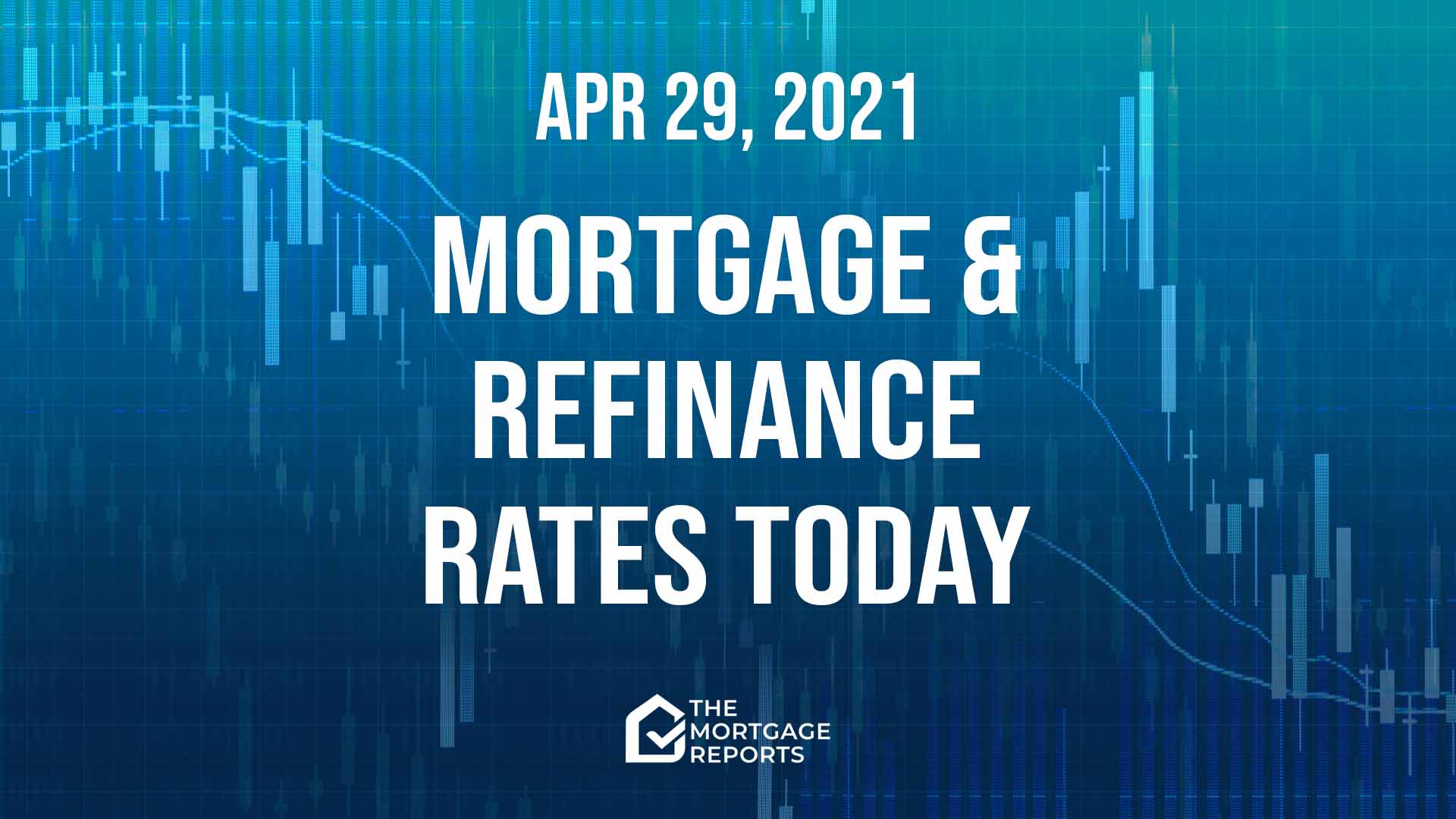
Today’s mortgage and refinance rates
Average mortgage rates held steady yesterday. And that continues a recent pattern of slowing falls. Do recent increases signal the resumption of 2021’s rising trend? Some think so. But it’s too soon to be sure.
There may be more bad news as mortgage rates look set to rise today. Good gross domestic product and weekly unemployment figures this morning — plus yesterday’s upbeat assessment of the economy’s future from the Federal Reserve — may be a turning point for mortgage rates. And that just might see a resumption of the upward trend. Read on for more.
Find and lock a low rate (Apr 29th, 2021)Current mortgage and refinance rates
| Program | Mortgage Rate | APR* | Change |
|---|---|---|---|
| Conventional 30 year fixed | |||
| Conventional 30 year fixed | 2.995% | 3% | -0.02% |
| Conventional 15 year fixed | |||
| Conventional 15 year fixed | 2.25% | 2.367% | Unchanged |
| Conventional 20 year fixed | |||
| Conventional 20 year fixed | 2.75% | 2.842% | Unchanged |
| Conventional 10 year fixed | |||
| Conventional 10 year fixed | 1.942% | 2.086% | -0.14% |
| 30 year fixed FHA | |||
| 30 year fixed FHA | 2.809% | 3.466% | Unchanged |
| 15 year fixed FHA | |||
| 15 year fixed FHA | 2.564% | 3.149% | Unchanged |
| 5 year ARM FHA | |||
| 5 year ARM FHA | 2.5% | 3.201% | -0.01% |
| 30 year fixed VA | |||
| 30 year fixed VA | 2.375% | 2.547% | -0.03% |
| 15 year fixed VA | |||
| 15 year fixed VA | 2.25% | 2.571% | Unchanged |
| 5 year ARM VA | |||
| 5 year ARM VA | 2.5% | 2.379% | -0.01% |
| Rates are provided by our partner network, and may not reflect the market. Your rate might be different. Click here for a personalized rate quote. See our rate assumptions here. | |||
COVID-19 mortgage updates: Mortgage lenders are changing rates and rules due to COVID-19. To see the latest on how coronavirus could impact your home loan, click here.
Should you lock a mortgage rate today?
I’ve been embarrassed in recent weeks to have had to leave all my rate lock recommendations (below) on Lock. Mortgage rates have been falling for most of April. But I couldn’t switch those recommendations to Float because I was convinced rates would rise again soon. I just didn’t know when.
So all I could do was encourage people not to lock on days when rates were falling. But to make sure they’d be able to lock when they needed to.
Falls have been much shallower in the second half of the month. And some now believe they’re going to start to rise again very soon. Read on for the details.
And, for now, my personal rate lock recommendations remain:
- LOCK if closing in 7 days
- LOCK if closing in 15 days
- LOCK if closing in 30 days
- LOCK if closing in 45 days
- LOCK if closing in 60 days
But I don’t claim perfect foresight. And your personal analysis could turn out to be as good as mine — or better. So you might choose to be guided by your instincts and your personal tolerance for risk.
Market data affecting today’s mortgage rates
Here’s a snapshot of the state of play this morning at about 9:50 a.m. (ET). The data, compared with roughly the same time yesterday, were:
- The yield on 10-year Treasurys rose to 1.69% from 1.63% (Bad for mortgage rates.) More than any other market, mortgage rates normally tend to follow these particular Treasury bond yields, though less so recently
- Major stock indexes were higher on opening. (Good for mortgage rates.) When investors are buying shares they’re often selling bonds, which pushes prices of those down and increases yields and mortgage rates. The opposite happens when indexes are lower
- Oil prices climbed to $65.15 from $63.68 a barrel. (Bad for mortgage rates*.) Energy prices play a large role in creating inflation and also point to future economic activity.
- Gold prices edged lower to $1,767 from $1,770 an ounce. (Neutral for mortgage rates*.) In general, it’s better for rates when gold rises, and worse when gold falls. Gold tends to rise when investors worry about the economy. And worried investors tend to push rates lower
- CNN Business Fear & Greed index — Rose to 68 from 62 out of 100. (Bad for mortgage rates.) “Greedy” investors push bond prices down (and interest rates up) as they leave the bond market and move into stocks, while “fearful” investors do the opposite. So lower readings are better than higher ones
Caveats about markets and rates
Before the pandemic and the Federal Reserve’s interventions in the mortgage market, you could look at the above figures and make a pretty good guess about what would happen to mortgage rates that day. But that’s no longer the case. We still make daily calls. And are usually right. But our record for accuracy won’t achieve its former high levels until things settle down.
So use markets only as a rough guide. Because they have to be exceptionally strong or weak to rely on them. But, with that caveat, so far mortgage rates today look likely to rise. Just be aware that intraday swings (when rates change direction during the day) are a common feature right now.
Find and lock a low rate (Apr 29th, 2021)
Important notes on today’s mortgage rates
Here are some things you need to know:
- Typically, mortgage rates go up when the economy’s doing well and down when it’s in trouble. But there are exceptions. Read ‘How mortgage rates are determined and why you should care
- Only “top-tier” borrowers (with stellar credit scores, big down payments and very healthy finances) get the ultralow mortgage rates you’ll see advertised
- Lenders vary. Yours may or may not follow the crowd when it comes to daily rate movements — though they all usually follow the wider trend over time
- When daily rate changes are small, some lenders will adjust closing costs and leave their rate cards the same
- Refinance rates are typically close to those for purchases. But some types of refinances are higher following a regulatory change
So there’s a lot going on here. And nobody can claim to know with certainty what’s going to happen to mortgage rates in coming hours, days, weeks, or months.
Are mortgage and refinance rates rising or falling?
Today and soon
Are we about to see a resumption of 2021’s upward trend in mortgage rates? Some analysts believe we are. And, yesterday, CNBC quoted two specialist companies that think so. The first was RBC, which announced that it was, “taking outright short positions on the benchmark U.S. 10-year Treasury.”
That means that RBC is laying bets that the yield on 10-year Treasurys will rise. And, as you know, mortgage rates more closely shadow that market than any other. CNBC went on:
Jefferies macro strategists supported this outlook in a note Wednesday, with U.S. economist Aneta Markowska projecting the U.S. 10-year will resume its climb to 2% by the end of the year, with risks building to the upside.
We’ve been discussing market indecision for a few days now, as investors seemed torn between good news at home and pandemic problems overseas. But the headline above the story containing those reports was “Short U.S. and UK bonds as market indecision comes to an end, analysts say.”
Some of that move from indecision may have been down to the Federal Reserve’s news conference yesterday afternoon. Fed Chair Jerome Powell was even more upbeat over the prospects for the US economy than he already was. But he reassured markets that his organization had no short-term plans to hike rates or taper its asset purchases. More excellent economic data this morning can only have added to the momentum.
Will RBC and Jefferies be proved correct? It’s too early to say for sure. But they sound about right to me.
For more background on my wider thinking, read our latest weekend edition, which is published every Saturday soon after 10 a.m. (ET).
Recently
Over much of 2020, the overall trend for mortgage rates was clearly downward. And a new, weekly all-time low was set on 16 occasions last year, according to Freddie Mac.
The most recent weekly record low occurred on Jan. 7, when it stood at 2.65% for 30-year fixed-rate mortgages. But then the trend reversed and rates rose.
However, those rises were replaced by falls in April, though those have moderated since the middle of the month. Indeed, Freddie’s Apr. 29 report puts that weekly average at 2.98% (with 0.7 fees and points), up from the previous week’s 2.97%.
Expert mortgage rate forecasts
Looking further ahead, Fannie Mae, Freddie Mac and the Mortgage Bankers Association (MBA) each has a team of economists dedicated to monitoring and forecasting what will happen to the economy, the housing sector and mortgage rates.
And here are their current rates forecasts for the remaining quarters of 2021 (Q2/21, Q3/21, Q4/21) and the first quarter of 2022 (Q1/22).
The numbers in the table below are for 30-year, fixed-rate mortgages. Freddie’s were updated on April 14, Fannie’s on April 12 and the MBA’s on April 22.
| Forecaster | Q2/21 | Q3/21 | Q4/21 | Q1/22 |
| Fannie Mae | 3.2% | 3.3% | 3.4% | 3.5% |
| Freddie Mac | 3.2% | 3.3% | 3.4% | 3.5% |
| MBA | 3.4% | 3.6% | 3.7% | 3.9% |
However, given so many unknowables, the current crop of forecasts might be even more speculative than usual.
Find your lowest rate today
Some lenders have been spooked by the pandemic. And they’re restricting their offerings to just the most vanilla-flavored mortgages and refinances.
But others remain brave. And you can still probably find the cash-out refinance, investment mortgage or jumbo loan you want. You just have to shop around more widely.
But, of course, you should be comparison shopping widely, no matter what sort of mortgage you want. As federal regulator the Consumer Financial Protection Bureau says:
Verify your new rate (Apr 29th, 2021)Shopping around for your mortgage has the potential to lead to real savings. It may not sound like much, but saving even a quarter of a point in interest on your mortgage saves you thousands of dollars over the life of your loan.



